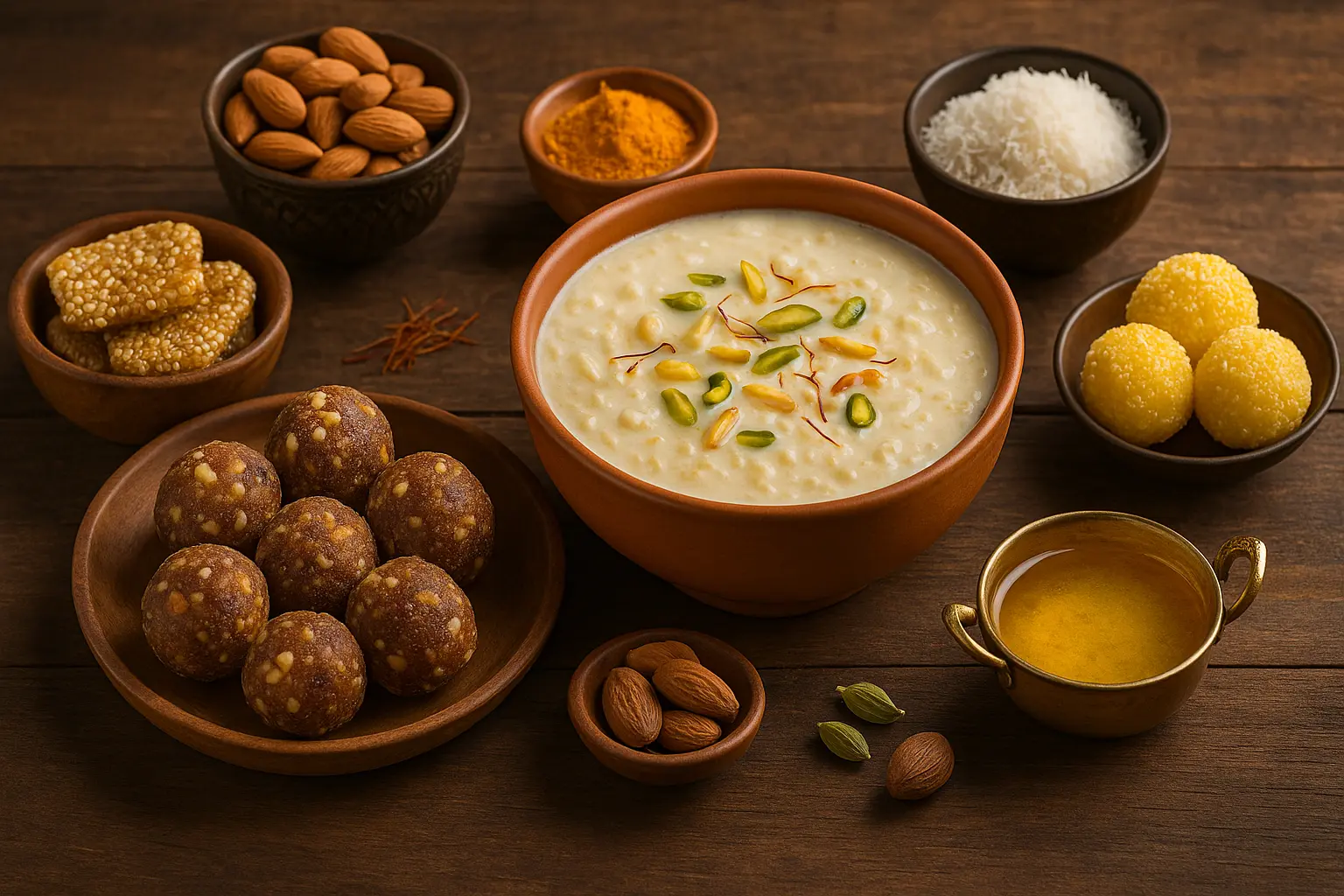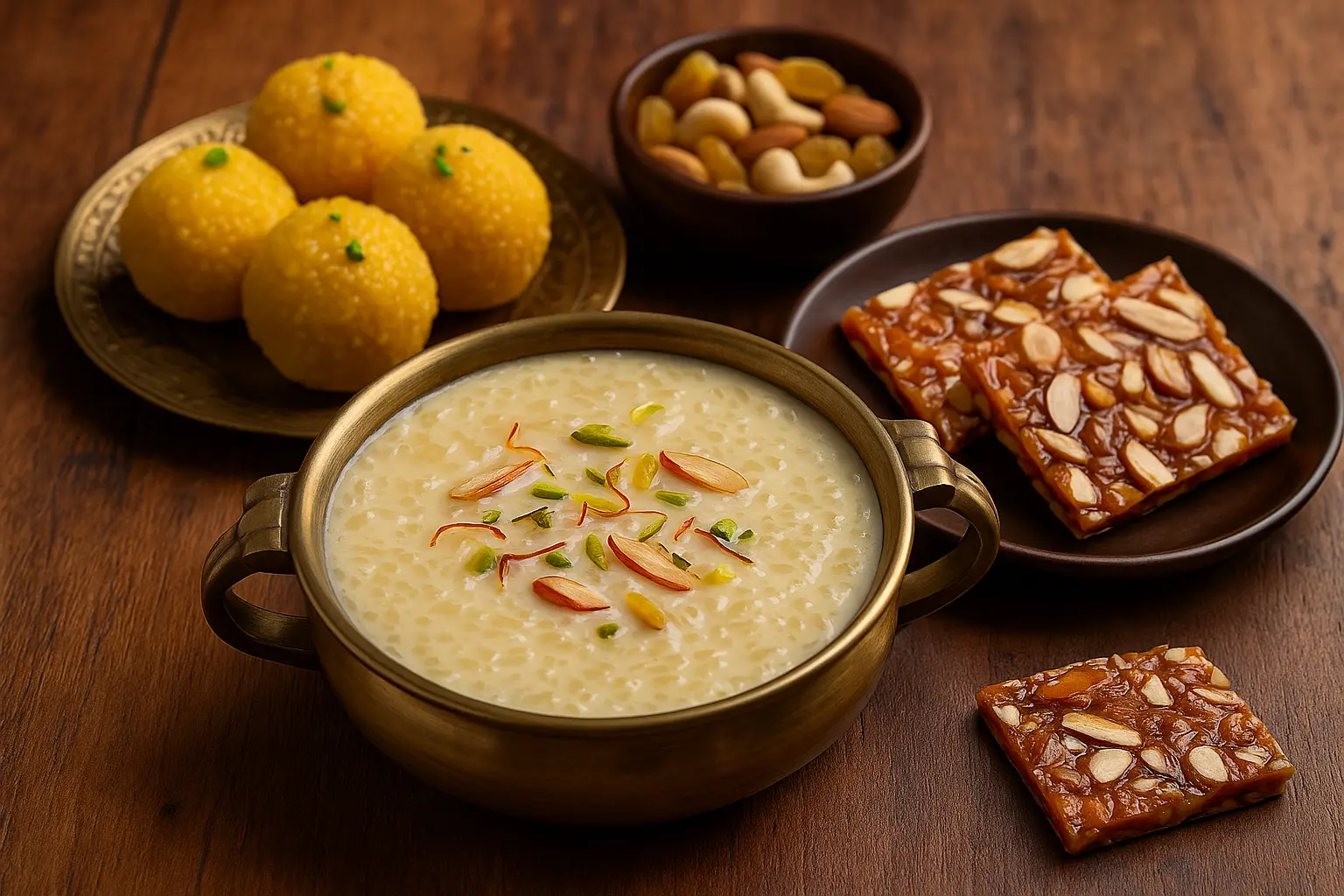Desserts have always held a special place in Indian culture. Whether it’s the comforting bowl of kheer shared at family gatherings, the melt-in-your-mouth ladoos at festive celebrations, or the delicately spiced payasam at temple offerings, sweets symbolize abundance, joy, and auspiciousness. But in today’s world, where health-conscious eating is becoming the norm, many people are looking for desserts that are not just indulgent but also nourishing.
This is where Ayurvedic desserts come in. Rooted in the ancient wisdom of Ayurveda, these desserts focus on balancing flavor with health. Instead of refined sugar, artificial colors, or heavy creams, Ayurvedic sweets rely on natural sweeteners like jaggery, dates, or honey, wholesome flours, ghee for digestion, and healing spices like cardamom, saffron, nutmeg, and turmeric. Each ingredient is thoughtfully chosen not just for taste but also for its effect on the body, mind, and spirit.

Understanding the Ayurvedic Approach to Desserts
The Philosophy of Ayurveda and Sweets
Ayurveda, the 5,000-year-old system of natural healing from India, emphasizes balance—between the body, mind, and environment. Food plays a central role in maintaining this balance. According to Ayurveda, desserts can be health-supportive when prepared with sattvic (pure and wholesome) ingredients and consumed mindfully.
- Dosha Balance: Every individual has a unique constitution (Vata, Pitta, or Kapha). Ayurvedic desserts often use spices and ingredients that balance these doshas.
- Sattvic Qualities: Desserts made with natural ghee, nuts, grains, and fruits are considered sattvic, which means they promote clarity, calmness, and vitality.
- Digestive Harmony: Spices like cardamom and nutmeg are added not just for aroma but also to aid digestion.
Why Natural Sweeteners Are Central
Refined sugar is considered heavy and harmful in Ayurveda, leading to imbalances. Instead, natural sweeteners are preferred:
- Jaggery (gur): Provides iron and minerals, boosts digestion.
- Dates and figs: High in fiber, rich in energy.
- Honey (madhu): Balances Kapha, aids in immunity.
- Coconut sugar: Has a low glycemic index, making it more stable for blood sugar.
Popular Ayurvedic Desserts
1. Date & Nut Ladoo
A classic no-cook dessert made with ground dates, almonds, walnuts, sesame seeds, and cardamom. These ladoos are high in energy, rich in minerals, and naturally sweet without added sugar.
- Health Benefits: Boosts stamina, supports digestion, and satisfies sweet cravings healthily.
- Festive Use: Popular during Diwali, Navratri, or as an everyday snack.
2. Moong Dal Payasam (Kheer)
Prepared with moong dal, jaggery, coconut milk (or cow’s milk), cardamom, and ghee. This golden-hued dessert is light yet nourishing.
- Health Benefits: Good for digestion, protein-rich, cooling when made with coconut milk.
3. Chyawanprash-Inspired Halwa
A modern twist inspired by the Ayurvedic tonic. Prepared with amla (Indian gooseberry), jaggery, ghee, and a mix of Ayurvedic herbs and spices.
- Health Benefits: Immunity booster, antioxidant-rich, and energizing.
4. Sesame-Jaggery Chikki
Made with roasted sesame seeds and melted jaggery, this crunchy brittle is both a snack and a festive treat.
- Health Benefits: Sesame supports bone health, jaggery detoxifies blood, and the combination keeps you warm in winter.
5. Saffron-Cardamom Kheer
A luxurious rice pudding made with basmati rice, jaggery, saffron strands, and cardamom pods.
- Health Benefits: Calms the mind, promotes sound sleep, balances Vata dosha.
6. Turmeric Coconut Ladoo
Prepared with desiccated coconut, jaggery, ghee, and a pinch of turmeric.
- Health Benefits: Anti-inflammatory, strengthens immunity, and promotes healing.
Key Ingredients in Ayurvedic Desserts
- Ghee: Improves digestion, lubricates joints, enhances flavor.
- Cardamom: Aids in digestion, relieves bloating, sweetens breath.
- Saffron: Improves mood, supports reproductive health.
- Nutmeg: Calms the nervous system, promotes restful sleep.
- Coconut: Cooling in nature, balances Pitta, provides healthy fats.
- Almonds & Cashews: Strengthen immunity, rich in protein and good fats.
Seasonal and Festive Connections
In Ayurveda, eating according to the season (Ritucharya) is essential. Desserts often reflect this principle:
- Winter: Sesame chikki, ghee ladoos, warm kheer with nuts.
- Summer: Coconut-based sweets, cooling rice puddings, fruit desserts.
- Festivals: Each celebration has its Ayurvedic sweet—Diwali ladoos, Pongal sweet rice, Navratri payasam.
Adapting Ayurvedic Desserts for Modern Lifestyles
- Vegan Options: Replace ghee with coconut oil, cow’s milk with almond or oat milk.
- Gluten-Free Choices: Use rice flour, millet flour, or besan instead of wheat flour.
- Diabetic-Friendly: Opt for coconut sugar or stevia-based versions of kheer and ladoos.
- Quick Fix Recipes: Energy balls, no-bake ladoos, or stove-top payasam ready in under 20 minutes.
Tips for Making Ayurvedic Desserts Healthier
- Always roast flours in ghee to make them lighter for digestion.
- Add spices like cardamom, saffron, or cinnamon for taste and medicinal value.
- Use jaggery syrup instead of refined sugar syrup.
- Practice portion control—Ayurveda emphasizes moderation.
- Prepare sweets fresh and avoid refrigeration for too long, as Ayurveda values freshness (prana).
Sample Recipe: Jaggery Rice Kheer (Ayurvedic Style)
Ingredients:
- ½ cup basmati rice
- 3 cups milk (or coconut milk)
- ½ cup grated jaggery
- 2 tbsp ghee
- 1 tsp cardamom powder
- A few saffron strands
- 2 tbsp chopped almonds & cashews
Method:
- Wash rice and cook in milk on low flame until soft.
- In another pan, melt jaggery with 2 tbsp water. Strain to remove impurities.
- Add jaggery syrup to the cooked rice-milk mixture.
- Stir in ghee, saffron, cardamom, and nuts.
- Serve warm, garnished with more nuts.
Benefits: Nourishing, cooling, easy to digest, balances Pitta dosha.
The Mindful Way of Eating Ayurvedic Desserts
Ayurveda encourages mindful eating practices. When enjoying desserts:
- Sit in a calm environment.
- Eat slowly, savoring flavors.
- Avoid overeating, especially at night.
- Pair sweets with warm herbal teas (like fennel or ginger tea) for better digestion.
Conclusion
Ayurvedic desserts are more than just indulgences—they’re tools of nourishment, healing, and joy. By swapping refined sugar and processed ingredients for jaggery, dates, nuts, ghee, and medicinal spices, these sweets let us enjoy festive traditions without compromising health. Whether it’s a ladoo for Diwali, a bowl of saffron kheer for a family dinner, or an everyday date ball as a snack, Ayurvedic desserts remind us that food can be both delicious and medicinal.
Leave a comment
Your email address will not be published. Required fields are marked *




















